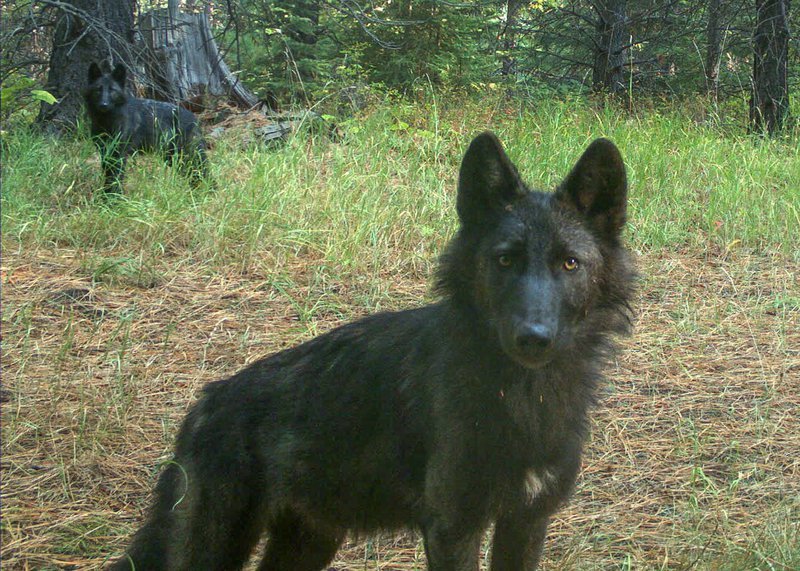New Wolf Family Discovered in Oregon Raises Hope for the Species
Sightings of two adults and two pups in the state where gray wolves are federally protected has been hailed by conservationists as "an exciting new chapter" for the species.
Wenaha wolf pup. Credit: ODFW
Photographs of a new family of gray wolves in Oregan’s Cascade mountains have raised optimism for the species that has been subject to widespread persecution across the United States.
The two adults and two pups were captured by tribal biologists via a trail camera on the Warm Springs reservation in August.
The area where they were spotted has been designated a new area of known wolf activity (AKWA) and if all four members of the new wolf pack are still alive by the end of 2022, they will be formally named the Warm Springs pack, according to officials.
“I’m so grateful this new family is making its home in a part of Oregon where wolves are still protected under federal law,” said Amaroq Weiss, senior wolf advocate at the Center for Biological Diversity. “Illegal wolf killing is rampant in Oregon, so these animals need every possible safeguard. I hope this will be an exciting new chapter in the story of wolf recovery in the state, which is seeing wolves dispersing into territory where they haven’t lived for decades.”
Credit: ODFW
Throughout the 1920s and ‘30s, more than 21,000 wolves were being slaughtered every year and by the middle of the century the species had been practically wiped out across the 48 contiguous U.S. states.
In 1974, the Endangered Species Act was passed and just one year later, the U.S. Fish and Wildlife Service granted the gray wolf protection under this legislation, allowing wolf numbers to slowly climb upwards. 175 individuals in more than 35 packs were estimated to be living in Oregon by the end of 2021, according to the Center for Biological Diversity, an increase of only two wolves from the previous year.
“The wolf count did not increase as much over the past year as in previous years, and a higher number of mortalities that included the loss of breeding adults certainly played a role,” said Roblyn Brown, an ODFW wolf biologist.
Eight wolves were illegally killed by poisoning in northeastern Oregon last year, where federal protections are absent. Those crimes remain unsolved, despite reward offers approaching $50,000 from conservation groups. Another wolf was found illegally killed in northeast Oregon in August, and a reward of $11,500 has been offered by conservation groups.
“It’s a bittersweet moment for Oregon’s wolves,” said Weiss. “With illegal wolf killings in eastern Oregon at all-time highs, having more wolves establish home territories and families in western Oregon will be crucial for the long-term survival of these beautiful animals.”
The Warm Springs group of wolves is the third to be documented in the northern Cascades region, along with the White River group's three wolves and the Metolius group's two.
In February this year, gray wolves across most of the continental United States regained federal protections following a court ruling on Thursday that overturned a Trump administration decision to delist the animals.
During the court ruling, Judge Jeffrey White of the U.S. federal district court for the Northern District of California, criticised the FWS for a number of legal and scientific errors, including its failure to assess threats to wolves across their entire range.
However, the protections were not extended to gray wolves in the Northern Rocky Mountain states of Idaho and Montana where the animals have been hunted relentlessly after aggressive wolf-killing laws were passed.
It’s estimated that around 15,000 gray wolves remain in the U.S., including Alaska, according to the Wolf Conservation Center. Uncertainty surrounds the number of wolves that formerly roamed North America before European colonists came, although the Center for Biological Diversity estimates that number to be as high as two million.
"It didn't take long for us to wipe them out," Weiss told CBC radio. "Settlers moved west and cleared the land for their grain and their livestock. We wiped out all the wolves' prey, the deer and the elk and the bison … and then we wiped out the predators that fed on those animals because those predators were then turning to livestock."
She says it’s our responsibility to undo the damage that we’ve caused to the species.
"We cleaned house, and we have obligations, moral obligations, to this species to bring them back. [We also have] ecological obligations, because having wolves back makes for a healthier place on the landscape,"
Weiss added that wolves’ impact on the ecological balance in crucial: "all of this stuff is interconnected and if you can put these integral pieces back, like the wolves, you can begin to rebuild the health of an ecosystem."
Learn more about the current war on wolves by listening to this Species Unite podcast series, where our host and founder Elizabeth Novogratz speaks with wolf experts, photographers, and conservationists to discover what we can do to stop the killings.
More stories:
Species Unite
A collection of stories of those who fight the good fight on behalf of animals.





Evaluating drugs with cutting-edge technology instead of animal testing will improve drug safety and cut development times, the agency said as it reveals a roadmap to increase non-animal research techniques.